
When Portland's WNBA Team Lit Up the Rose Garden
As basketball fans in Seattle and Las Vegas cheer on the Storm and the Aces in the WNBA Finals this week, Portlanders might feel left out. But we did have a WNBA team, once. Here’s a look back at the Portland Fire.
Jackie Stiles looked over the room service menu in disbelief. She had not eaten since the Portland Fire’s game against the hometown Phoenix Mercury a few hours prior, but no amount of hunger could drive her to blow her entire per-diem on a burger and fries. She took the elevator down to the lobby of the Ritz-Carlton in search of something cheaper and found teammate Sylvia Crawley in the same predicament: hungry, but not that hungry. There was a string of fast food restaurants a few minutes away. They asked the desk attendant to call for a car and stepped out into the hot Arizona night to wait.
Only the car that pulled around wasn’t a yellow cab, a shuttle bus, or even a hotel-owned SUV.
“We walked outside and they said, ‘Your car is ready,’ and it was a limo,” remembers Stiles. “We got in and went through the late-night window at Wendy’s and ordered our food. The driver asked us if that was the only place we wanted to go, and we said yes, but by the time we took the limo to Wendy’s it might have been cheaper to just order room service.”
Twenty years removed from its inaugural season, the Fire’s from-scratch roster, wholesome head coach, and overachieving on-court product are entrenched in Portland sports lore. The team came to town when Portland’s pro sports scene was relatively uncrowded. The Thorns’ soccer league didn’t exist yet and the modern Timbers would not begin play for another year, and even then, not as a member of Major League Soccer but the lower-tier United Soccer Leagues. The city’s appetite for basketball had swelled following back-to-back Western Conference Finals appearances by the Trail Blazers. The Fire may not have landed in any conference finals, but the team’s record improved each season and there was a sense that something was really building in the Rose Garden. Stiles, drafted before the team’s second year, was a star. Crawley, who also played for the Portland Power in the earlier American Basketball League, was dunking in warm-ups. They were riding in style with the windows down. And then it was over.
Years before the WNBA expanded to the Pacific Northwest, the core of the Fire franchise began to take shape in, of all places, central Kansas. Aside from producing Fire coach and general manager Linda Hargrove, Udall, Kansas, is most often associated with the devastating F5 tornado that decimated the town in 1955. The Hargrove family moved to the town in 1958 and was greeted by a population was still shaken. Several of Hargrove’s classmates lost limbs in the disaster, and many of her grade school peers began to cry anytime lightning struck or thunder boomed. Some of the structures had been rebuilt, but very few trees remained.
“I love trees now, and I think that is a big reason why—that when I was growing up there were basically no trees because they had all been torn out from the tornado,” remembers Hargrove.
She was raised on the family farm outside of town, milking cows, working the fields, and, later, working in the restaurant her family eventually bought: the Udall Drive In. She cooked burgers, waited tables, and baked cinnamon rolls. Linda and her two sisters were worked equally as hard as their one brother.
“Growing up in a house with my dad, there was no difference,” she says of gender in the Hargrove house. “You never thought that just because you were a girl you couldn’t do certain things. That work ethic was definitely instilled at an early age. The whole Kansas values—there are a lot of people who grow up in Kansas like that who learn to work hard, set goals, and strive to reach them. My early days on the farm and in the restaurant had a lot to do with that.”

Image: Brian Breneman
Hargrove never played basketball. She excelled as a runner and, after founding the girls track team at her high school, did the same at Cowley College in nearby Arkansas City. The team had two members its first season, but swelled to double digits by the second year. The Cowley administration was so impressed by her initiative and resourcefulness that the school’s president invited her to return to campus after graduation to start more women’s sports teams, starting with basketball and volleyball. Once the programs were created, each needed a coach, and she assumed the role for both. By the end of her 17-year tenure at Cowley she had coached basketball, volleyball, track, softball, and tennis. She had also served as the sponsor for cheerleading, the school’s director of admissions, and the women’s region VI director for the National Junior College Athletic Association.
“It was a small school, and I basically did everything,” she remembers.
It was basketball that really drew her in, however, and would become the core of a long teaching and coaching career. She ultimately landed the head coach job at Wichita State. While Hargrove was with the Shockers, a girl named Jackie Stiles from the small Kansas town of Claflin was shattering state records and drawing national attention.
“Jackie probably didn’t know about me, but I knew about her,” Hargrove says. “When she was in high school I was still at WSU and she was winning everything, and not just basketball. She won state championships in track and was a great tennis player, too. Her work ethic was a legend already when she was still in Kansas.”
The Stiles work ethic that would ultimately earn her WNBA Rookie of the Year Award during her first season in Portland, in 2001, was molded in a household where, like the Hargroves’, gender was never a permitted excuse. Like her future coach, Stiles was the oldest and most competitive of four children, all of whom were multisport stars. She created “Stiles two-on-two,” which required all of the siblings to rotate teammates and play a best two-out-of-three series with each. The person with the most total victories after all three series was the winner. When she couldn’t rustle up a game in her neighborhood, she would accompany her father, the boys’ basketball coach at the local high school, to his practices.
Despite earning scholarship offers from big-name programs like UConn, Stiles elected to attend Southwest Missouri State (now Missouri State University), which competed in the same conference as Hargrove’s Shockers. When Hargrove pulled up to the arena in Wichita hours before her team hosted Stiles-led Southwest Missouri for the first time, she found the lot already full of fans eager to see Stiles in action, hoping to get tickets.
Hargrove did not forget about Stiles when she moved from Wichita State to the pros. After a stint coaching in the short-lived American Basketball League, Hargrove was hired to coach and manage the Portland franchise, part of a four-team expansion for the 2000 season by the WNBA.
Led by Crawley and Sophia Witherspoon, the Fire struggled to a 10–22 record in its inaugural season. But members of the nascent franchise could sense that the excitement and chemistry permeating every level of the organization was unique. Crawley says the cohesion between the front office and the basketball team, fused by Hargrove’s dual roles as coach and general manager, created an inclusive atmosphere.
“Portland was just different. It was like a very close-knit family,” Crawley says. “We knew the people in the front office, they were a part of the team. When your GM is your coach, she’s blending the front office with the team. It just made a difference. There was a sense of security, too, because we knew our coach wasn’t going to get fired by the GM because she was the GM, so we could just relax and play and not worry about those type of issues.”
Because the WNBA season takes place in the summer, Crawley returned to her alma mater, the University of North Carolina, to serve as an assistant coach during the winter months. Her ability to see the game from a coach’s perspective was an asset to Hargrove. Crawley carried a notebook to Fire practices and jotted down plays and drills the team went through. During timeouts in games, she would make suggestions to Hargrove based on what she saw on the floor. Hargrove would also trust Crawley, as the Fire’s captain, to make decisions in the best interest of the group, like whether to get up early for shoot-around or to let the team sleep in. It often depended on the city. In Los Angeles, a city where players liked to go out on the town, Crawley would suggest an early wake-up a means of tethering them to their rooms. Other mornings, after long travel or a rough game, she’d suggest a rest day. Hargrove almost always listened. Oh, and Crawley could dunk.
“She would entertain our fans in Portland by dunking in warm-ups,” says Hargrove. “That was pretty novel in the evolution of our game to have players who could dunk.”
The winter following the Fire’s first season, Jackie Stiles guided Southwest Missouri State on an improbable run to the NCAA Final Four. Hargrove had not forgotten about Stiles, but the run made it easy for her to convince other Fire decision makers that Stiles should be the team’s first pick, no. 4 overall, in the 2001 draft.
“Jackie was just the hottest thing in women’s basketball,” says Hargrove. “She was on TV all the time, she was leading her team to the Final Four in St. Louis, close to Missouri State, just a storybook situation for her. My oldest grandson, who was 4 years old at the time, called me the morning of the draft and said ‘Grandma, are you going to be able to get Jackie Stiles?’ It was always ‘Jackie Stiles,’ it was never just ‘Jackie.’ I told him I didn’t know, but I was going to try.”
Portland got its woman, and the Kansas nucleus of Hargrove and Stiles guided the Fire to improved win totals over each of the next two season. Along with her Rookie of the Year award, Stiles was named to the 2001 WNBA All-Star team. Portland is a long way from Kansas, culturally and geographically, and she leaned heavily on the connection with Hargrove while adjusting to her new life.
“You kind of connect with people that are from where you are from or have a similar upbringing,” Stiles says of their shared Kansas roots. “I thought she was raised how I was raised, with the same kind of values, and was familiar with the town I was from. Absolutely there was an instant comfort level and connection with her. We definitely bonded over that, it brought us a lot closer.”
The Fire had its best season in 2002. With a 16–12 record heading into the last four games of the season, the Fire looked poised for its first playoff berth. They had lost the next two games, setting up a must-win matchup with rival Seattle.
“It came right down to the wire, and I can remember distinctly Sue Bird [in her first year in the league] hitting a circus shot late in the game that gave them a two-basket lead before they pulled away at the end,” recalls Hargrove. “Had we been able to pull that one out and make the playoffs … I don’t know. I don’t know if things would have been any different in Portland.”
The team finished 16–16, a half game out of the playoffs. Hargrove flew back to Kansas with the intention of returning to Portland a few months later. She was at home when she got the call: there would be no next season. The Portland Fire was folding. The timing, just as the team was beginning to win, was wrenching.
“We were making progress,” says Hargrove. “We had a lot of support in the city and the Portland organization was so supportive of our team those three years we were there. We had a great relationship with the men’s team, I just felt like everything was growing like it needed to. We were really close to being where we wanted to be: in the playoffs consistently. We were right there.”
The team had been clicking with fans, too.
“By far the best in the league, hands down. Just incredible,” remembers Stiles of the support that had built up in such a short time. “[The Fire fans] gave you such energy and you felt like they were truly connected, like they cared about you as a person. They motivated me. I wanted to be great for them because they were the best fans in the league, that’s why it was so shocking to have our team fold because we had such good attendance and they supported us so much.”
Crawley made her way to San Antonio to join the Silver Stars (the team would move later move to Las Vegas and become the Aces) and Hargrove was hired by the Washington Mystics, but stepping into an already-formed entity didn’t carry the same thrill.
“Going to Portland was probably one of the most exciting times of my life in terms of putting something together from scratch,” says Hargrove. “I was the first person hired in that organization, and being able to put a staff together, put a team together, it was almost like birthing a child and watching them grow the first three years that we were there. It was just a very intimate thing, putting that team together, and we just had such great people with similar philosophies of working hard and working together.”
Incessant injuries—worsened at least in some part by the same work ethic that got her to the WNBA—forced Jackie Stiles into an early retirement. She followed Crawley and Hargrove into the coaching ranks and, after stops at Loyola Marymount and her alma mater, is currently as assistant coach at the University of Oklahoma. Crawley and Hargrove have both stepped away from coaching, but a few years ago, while Crawley was still with North Carolina, she was at a recruiting event scouting players when she heard a familiar voice.
“Syl!”
She turned around to find Stiles grinning up at her.
“Let’s go to Wendy’s!”
___
North Carolina–based writer Jarrett Van Meter is the author of How Sweet It Is, about Kentucky high school basketball.




